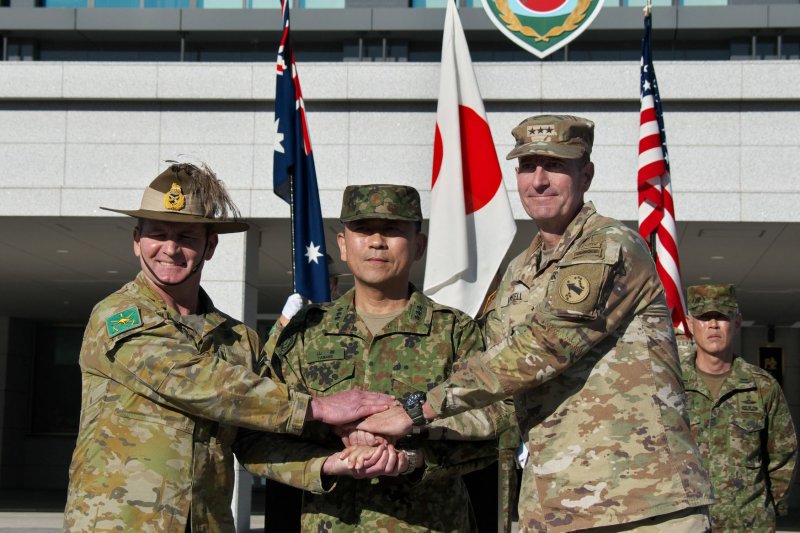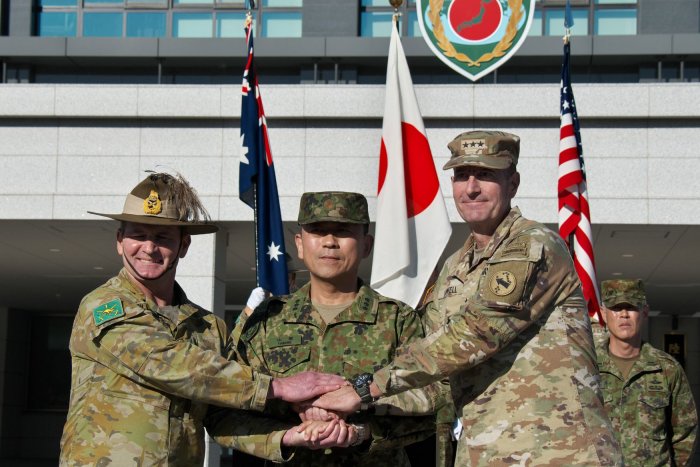1 of 6 | Australian Army 1st Division Commander, Maj Gen. Ash Collingburn (L), shakes hands with Japan Ground Self-Defense Force Commander Lt. Gen. Toshikazu Yamane (C) and U.S. Army Pacific Deputy Commanding General, Lt. Gen. Joel Vowell (R) during the the opening ceremony of Japan, U.S. and Australia joint command post exercise “Yama Sakura 87 at the Camp Asaka in Tokyo on Friday. Photo by Keizo Mori/UPI |
License PhotoDec. 6 (UPI) — The United States, Japan and Australia kicked off the annual Yama Sakura joint military exercise at Camp Asaka in Tokyo on Friday by touting “groundbreaking advancement” in the interoperability of their forces in the Indo-Pacific.
Like its predecessors, Yama Sakura 87 is a large-scale command post training exercise involving the Japan Ground Self-Defense Force, the U.S. Army and the Australian Defense Force and is meant to enhance the interoperability and mutual defense capabilities of the three nations.
Led by Gen. Yasunori Morishita, chief of staff the of JGSDF, it involves approximately 5,500 Japanese troops, 1,350 members of the U.S. military and 250 members of the Australian military. Some 140 members of the U.S. Marine Expeditionary Force III, based in Okinawa, will also be joining this year.
The exercise runs from Friday through Dec. 14.
Military officials from the three countries say the biggest development in this year’s event is that it is being held simultaneously with the Warfighter command post exercise, which is being conducted in Japan for the first time.
This combination is presenting the JGSDF with one of the best opportunities in its history to deepen and improve its interoperability with U.S. and Australian forces, they said.
JGSDF Ground Component Commander Gen. Toshikazu Yamane told reporters during an opening press conference the aim is to “further evolve our cooperation with the Marines in the field of island defense. Conducting exercises in cooperation with allies and like-minded countries will greatly contribute to the stability of our country.”
“Countering the threats of North Korea, Russia, and China cannot be done by one country alone,” added U.S. Army Pacific Deputy Commander Lt. Gen. J.B. Bowre. “Deterrence can only be achieved by cooperating with allies and like-minded countries.”
Australia, which had been an observer until 2022, is officially participating for the second year in a row.
Major Gen. Ash Collingburn, commander of the 1st Australian Division, said his country’s participation enhances interoperability and cooperation with some of its closest allies and partners.
“The 1st Australian Division continues to work with allies and partners on training exercises like Yama Sakura 87 to enhance interoperability in preparation for large-scale combat operations,” he said.
“The exercise will further strengthen the Australia-Japan-U.S. trilateral defense partnership and contribute to regional security, in support of a stable, secure and prosperous Indo-Pacific region.”
Left to right, Australian Army 1st Division commander Maj Gen. Ash Collingburn shakes hands with the commander-in-chief, Ground Component Command of Japan Ground Self-Defense Force, Lt. Gen. Toshikazu Yamane and U.S. Army Pacific deputy commanding general Lt. Gen. Joel Vowell during the the opening ceremony of joint command post exercise Yama Sakura 87 at Camp Asaka in Tokyo on December 6, 2024. Photo by Keizo Mori/UPI |
License Photo

